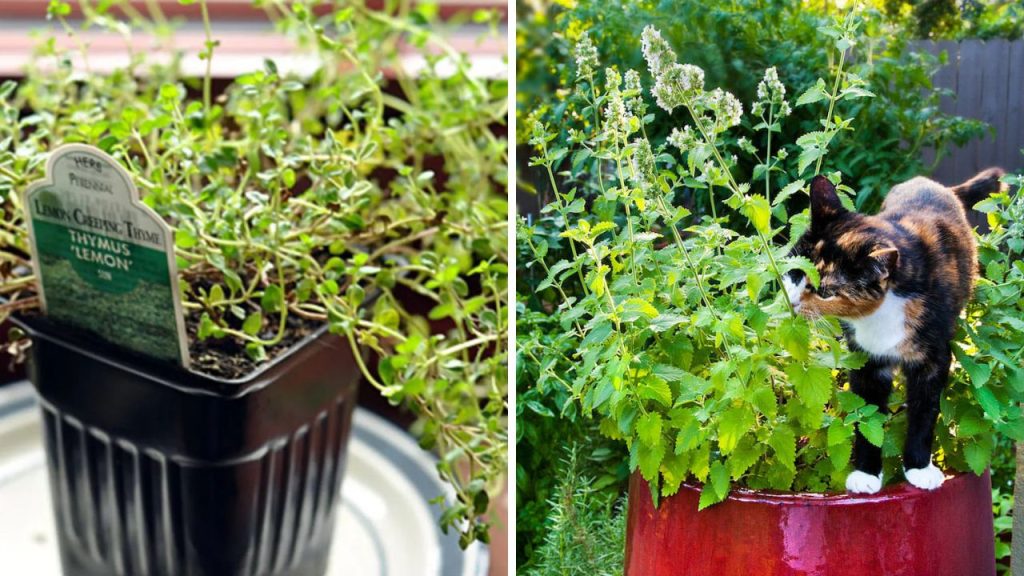Sprucing up your garden with beautiful blooms is easier than you think! This collection of 21 floral garden ideas using bulbs showcases a variety of stunning arrangements and creative techniques to bring color and life to your outdoor space. From vibrant tulips to delicate daffodils, there’s something for every gardener, whether you’re a seasoned pro or just starting out. Let’s dig in and explore these fun bulb ideas!
Container Gardening with Bulbs
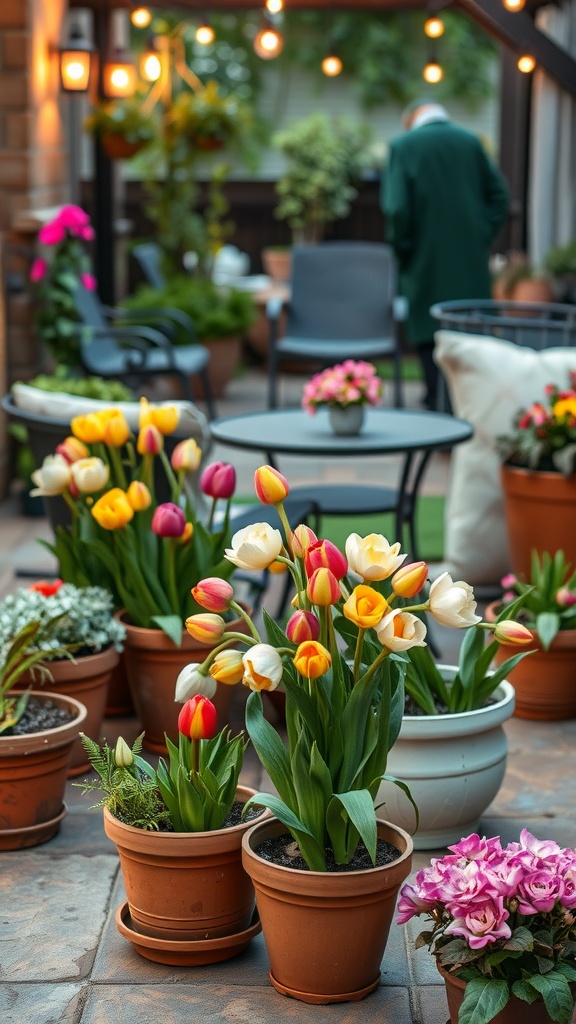
Container gardening with bulbs is a fantastic way to brighten up your space. Imagine a cozy patio filled with vibrant tulips and cheerful blooms in varied colors. Each flower pot brings a splash of life, making the area feel welcoming and warm.
The image captures this essence perfectly. You see pots of tulips in shades of yellow, red, and white, creating a delightful display. Surrounding these are other plants, adding to the overall charm of the setting. It’s a lovely option for those with limited space or for anyone who loves the look of flowers without the commitment of a full garden.
Using bulbs in containers allows you to mix and match your favorite flowers. You can easily change the arrangement with the seasons or your mood. Take care to choose pots with good drainage, and your bulbs will thrive, offering beauty and joy.
Naturalizing Bulbs in Grass
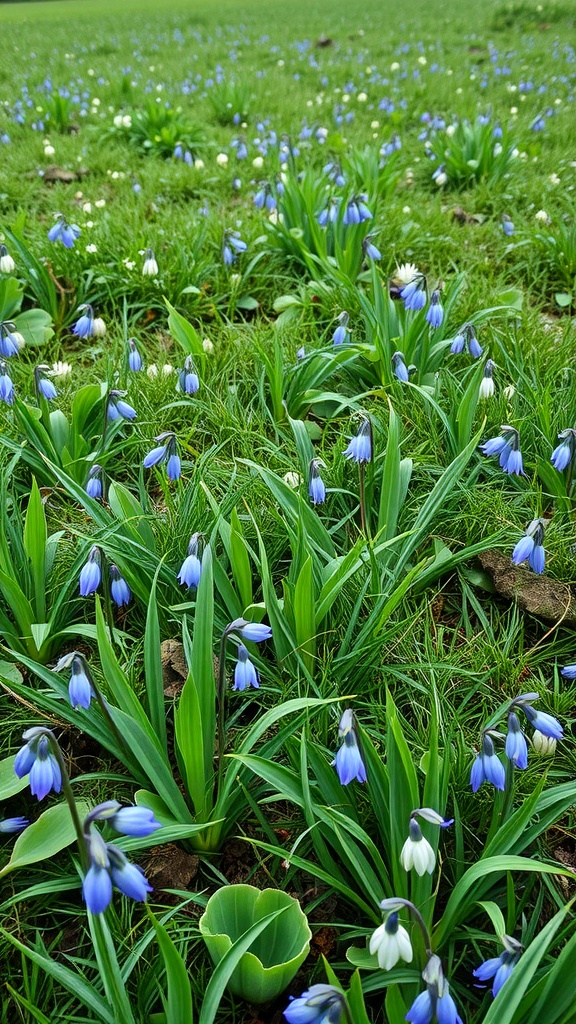
Imagine a lush, green lawn dotted with clusters of delicate blue flowers. This stunning scene showcases the beauty of naturalizing bulbs in grass. The vibrant blooms, seemingly scattered at random, create a charming, relaxed look that feels so inviting.
Spring is the perfect time to let bulbs like bluebells and snowdrops mingle with your grass. This method gives your garden a wildflower feel while keeping maintenance low. You’ll enjoy a beautiful display without the usual fuss.
To start, choose bulbs that are suited for naturalization. Plant them in the fall, and let nature do its thing. Over time, these bulbs multiply, ensuring a delightful show year after year. It’s a simple and effective way to brighten up your outdoor space.
As you walk through this grassy paradise, you’ll notice how the flowers sway gently in the breeze. Their soft colors contrast beautifully with the deep green grass, creating a peaceful and natural atmosphere. This is a great way to enhance your garden without overwhelming it.
Creating a Colorful Spring Display
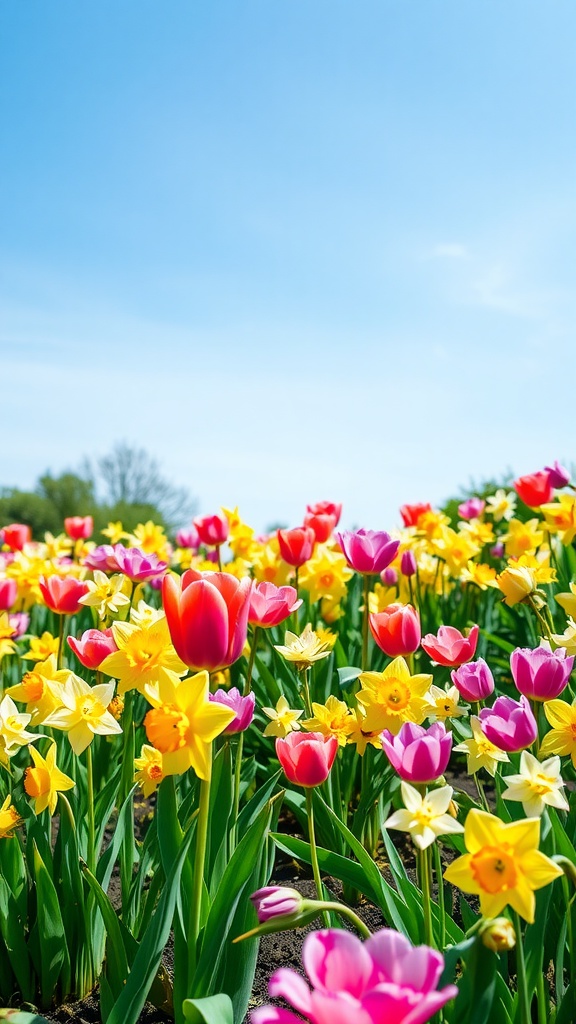
Spring is the perfect time to bring some color to your garden. Imagine walking through a garden filled with vibrant tulips and cheerful daffodils. The combination of pink, red, and yellow flowers creates a lively scene that can brighten anyone’s day.
Tulips stand tall with their elegant shapes, while daffodils add a playful touch with their trumpet-like blooms. Together, they create a stunning visual that draws the eye and lifts the spirit. This colorful arrangement not only looks beautiful but also signals the arrival of warmer days ahead.
To make the most of your spring display, consider planting a mix of these bulbs. You can choose different varieties to have flowers blooming at various times, ensuring your garden stays lively for weeks. Just imagine the joy of seeing fresh blooms pop up every few days!
Layering Bulbs for Year-Round Interest
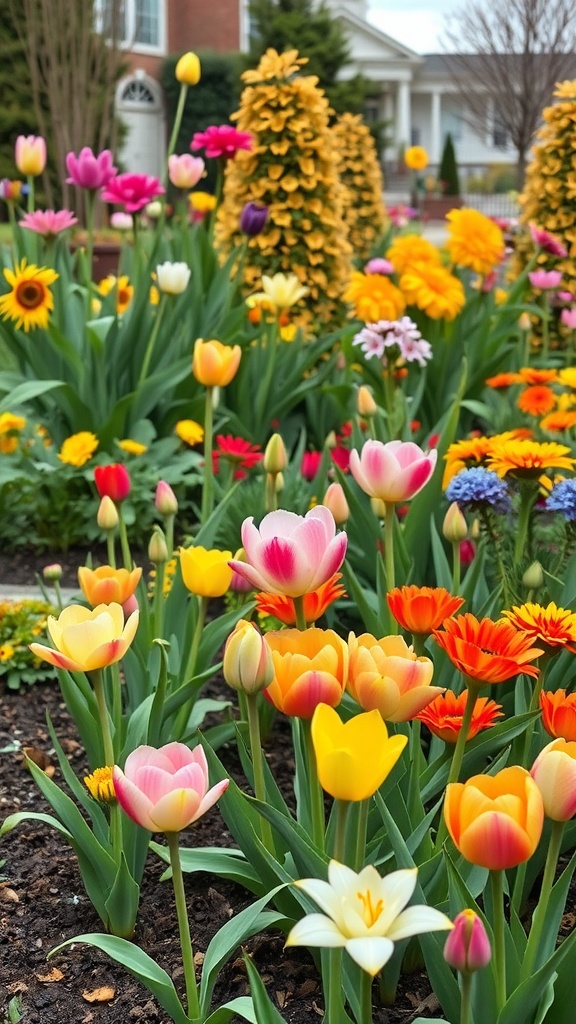
Imagine a garden bursting with color and life throughout the seasons! By layering bulbs, you can create a stunning floral display that evolves as the year progresses. The image above showcases a vibrant mix of flowers, primarily tulips, that thrive in spring. These cheerful blooms are just the beginning!
Start with early-blooming bulbs like crocuses and snowdrops. They peek through the soil as winter melts away, bringing hope and joy. Next, plant mid-season bulbs such as tulips and daffodils. Their bright hues fill the garden, attracting pollinators and enhancing the overall look.
To keep the beauty going, consider late bloomers like alliums and lilies. They will take over when the early flowers fade. This gradual transition keeps your garden lively and interesting. Mixing in some perennials can add even more texture and depth.
Layering bulbs not only adds visual appeal but also ensures that your garden is a delight across different seasons. It’s a simple strategy that can transform any space into a colorful sanctuary!
Cottage Garden with Bulb Accents
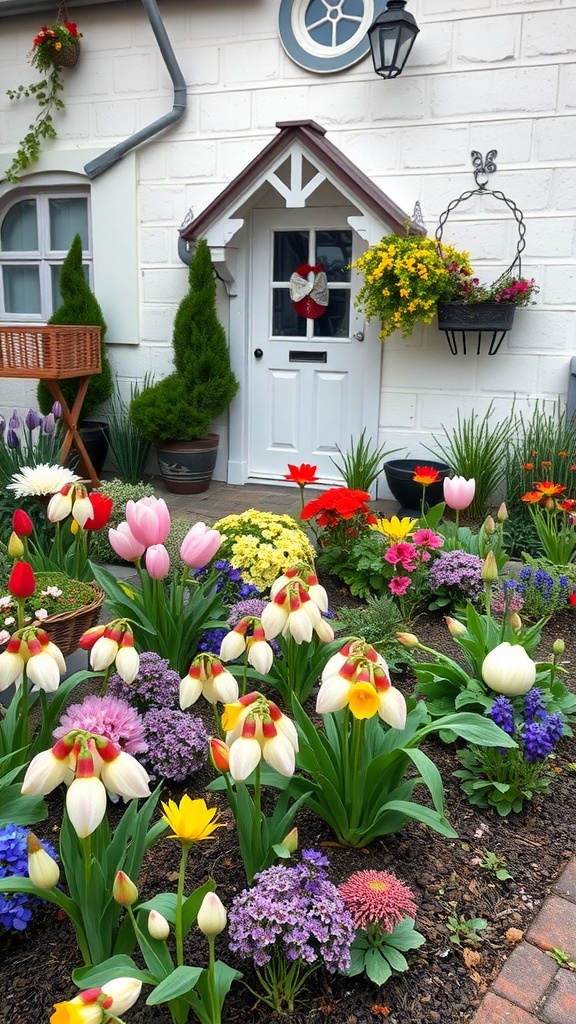
A cottage garden is the perfect spot for adding a splash of color and charm. This image showcases a delightful mix of vibrant blooms surrounding a quaint entrance. The cheerful arrangement of flowers creates a warm and inviting atmosphere.
Tulips in soft pinks and bold reds make a striking statement among other flowers. Their graceful shapes draw the eye and invite a closer look. The yellows and purples add depth, creating a rich tapestry of color.
Planting bulbs like these not only enhances the beauty but also brings life to the garden. They thrive in well-drained soil and can often return year after year, making them a great choice for any gardener.
Consider incorporating a variety of bulbs for a stunning display that changes with the seasons. This cottage garden style is not just about looks; it’s about creating a peaceful retreat where nature sings.
Bulb Combinations for a Fragrant Garden
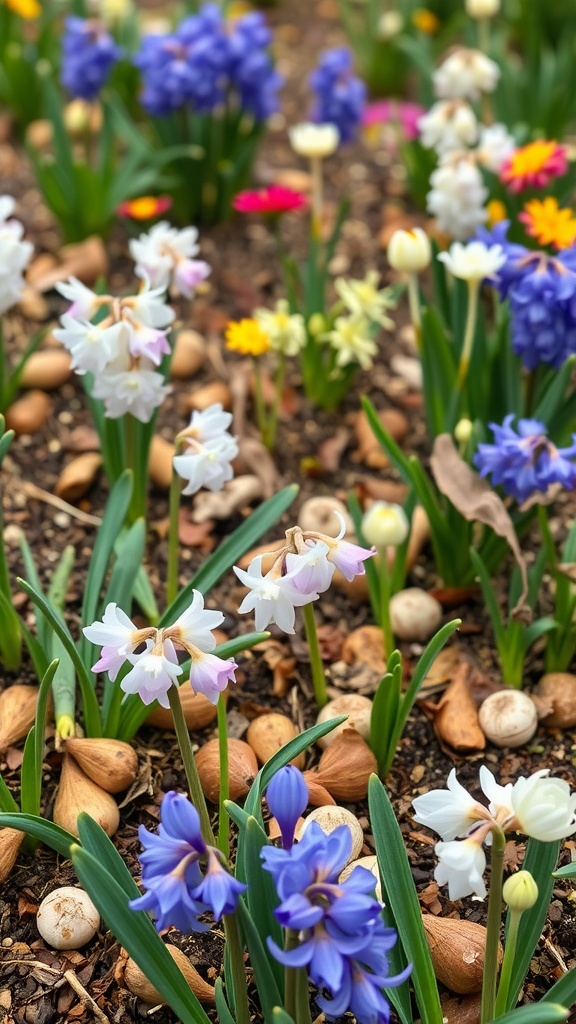
Creating a fragrant garden is a delightful way to brighten up your outdoor space. The image here showcases a beautiful mix of blooming flowers, including hyacinths and other vibrant varieties. These bulbs are not just visually appealing; they also release sweet scents that can fill the air with freshness.
When planning your garden, think about mixing different bulb types for a layered effect. Pair fragrant flowers like hyacinths with other blooms that have unique colors and shapes. This will create an inviting atmosphere that enhances your garden’s overall charm.
Consider planting clusters of these bulbs in well-drained soil to maximize their growth. Grouping them together allows their scents to mingle, creating a stronger fragrance. Also, don’t forget to choose bulbs that bloom at different times for continuous fragrance throughout the season.
Designing a Bulb-Focused Border
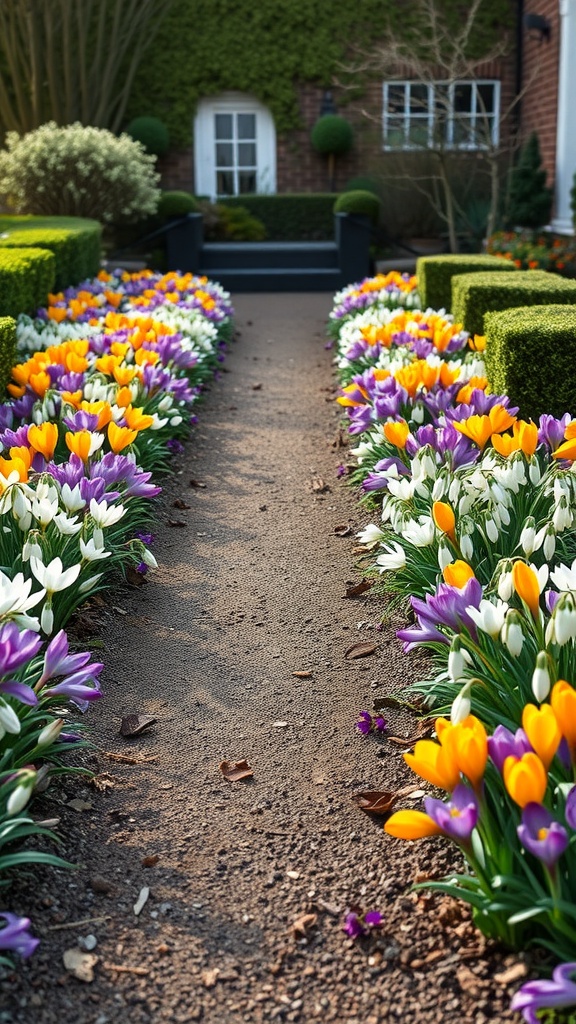
Creating a bulb-focused border can transform your garden into a splash of color. In the image, a lovely path is lined with vibrant crocuses in shades of purple, yellow, and white. These flowers are perfect for early spring, bringing a cheerful vibe as they bloom.
To design your border, start by selecting a variety of bulbs that complement each other. Mixing colors and flower types can create a stunning visual effect. The neat hedges on either side in the image add structure and contrast to the flowing shapes of the flowers.
Consider the height of your bulbs. Taller varieties can be placed at the back, while shorter ones should be in front to ensure every flower gets the spotlight. This layering effect helps to create depth and interest.
Don’t forget to think about the space around the border. The clear path in the image invites you to stroll through the blooms. A similar layout can help make your garden accessible and enjoyable. With a little planning, your bulb border can be a delightful feature that welcomes spring.
Mixing Annuals and Bulbs for a Dynamic Look
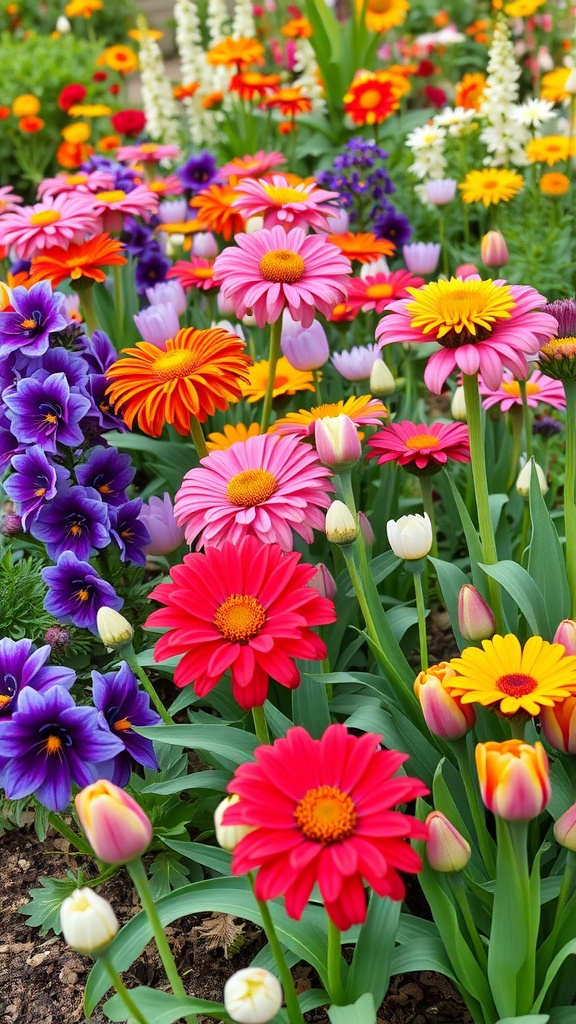
Creating a vibrant garden is as easy as mixing annuals with bulbs. The image shows a beautiful array of flowers in various colors, including bright pinks, reds, and purples. This combination adds depth and interest to any garden bed.
Annuals, like the cheerful daisies in the picture, bloom all season and can fill spaces quickly. They pair wonderfully with bulb flowers like tulips, which provide stunning blooms in early spring. The contrast in shape and size makes each flower pop.
When planning your garden, think about layering these flowers. Place taller bulbs in the back and shorter annuals in the front. This arrangement ensures that every flower can shine without overshadowing its neighbors. Plus, consider color combinations that complement each other. For instance, the warm yellows and reds in the image work perfectly with the cooler purple hues.
Incorporating a mix of textures and colors not only attracts pollinators, but it also gives your garden a lively, dynamic look. Don’t be afraid to experiment with different pairings to find what suits your style. Happy planting!
Growing Bulbs in Shaded Areas
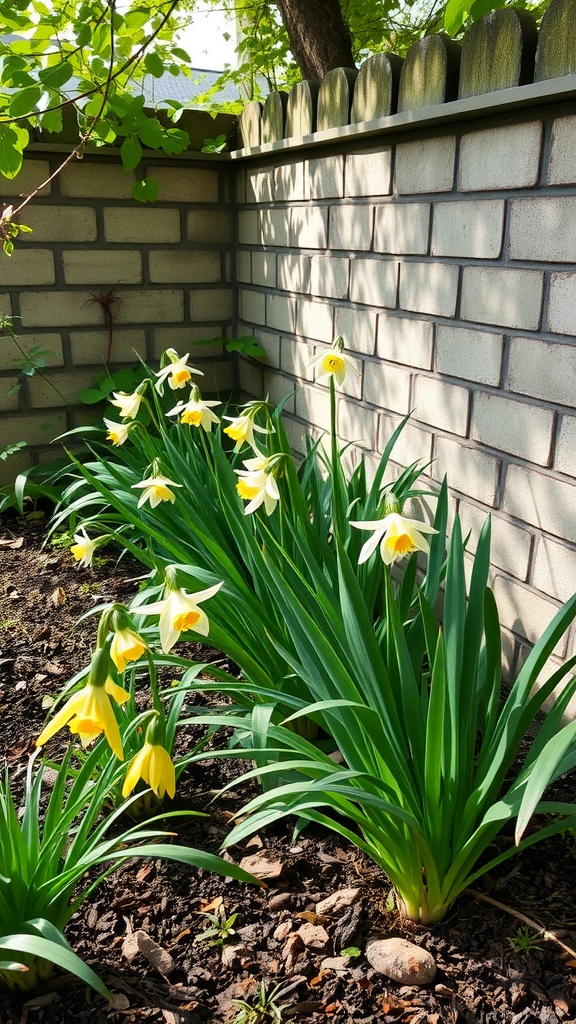
Shaded areas can be a great spot for growing bulbs, and they often surprise you with their beauty. In the image, you can see a cluster of yellow daffodils blooming next to a brick wall. These cheerful flowers thrive even in partial shade, making them perfect for areas beneath trees or near structures.
When planting bulbs in shady spots, it’s essential to choose varieties that don’t require full sun. Daffodils, snowdrops, and grape hyacinths are excellent options. They not only add color but also create a refreshing atmosphere.
Make sure to prepare the soil well by adding compost to provide nutrients. Watering is key, especially during dry spells. With the right care, your shaded garden will burst into life every spring!
Creating a Bulb Mosaic
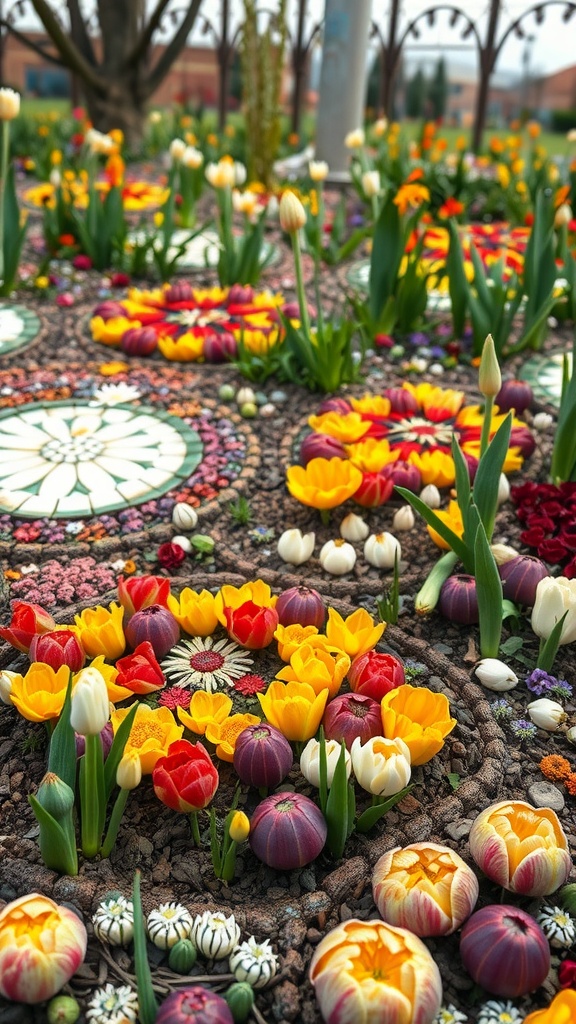
A bulb mosaic is a fun way to showcase your love for flowers. The image above captures a stunning arrangement of colorful bulbs that come together to form a beautiful design. With vibrant yellows, reds, and purples, these flowers create a lively atmosphere in any garden.
To create your own mosaic, start by planning your design. Use a mix of bulb types and colors for visual interest. Lay them out on the ground to see how they fit. When you’re happy with the arrangement, plant the bulbs in clusters for a cohesive look. This method not only looks great but also draws attention to the unique shapes and colors of each bulb.
Remember, the key to a successful bulb mosaic is variety. Mix in different textures and heights to keep it dynamic. Don’t be afraid to get creative! Your garden can be a canvas where you express your own style through colors and shapes.
Attracting Pollinators with Bulbs

Bright and cheerful, this garden scene showcases a variety of flowers in full bloom. The bold yellow and soft pink hues create a lively atmosphere, perfect for welcoming pollinators. Bees can be seen buzzing around the petals, enjoying the nectar from the blossoms. This vibrant display is not just pleasing to the eye; it plays a crucial role in supporting local ecosystems.
Using bulbs in your garden can significantly attract pollinators like bees and butterflies. Planting species such as tulips and daffodils ensures that these helpful insects are drawn to your space. These flowers bloom at different times, providing a continuous food source throughout the seasons.
Creating a garden rich in color and variety encourages pollinators to visit regularly. They are not only attracted to the bright flowers but also to the rich scents and the promise of nourishment. A diverse selection of bulbs can transform your backyard into a pollinator-friendly haven, helping to sustain their populations.
Incorporating Bulbs in Vertical Gardens
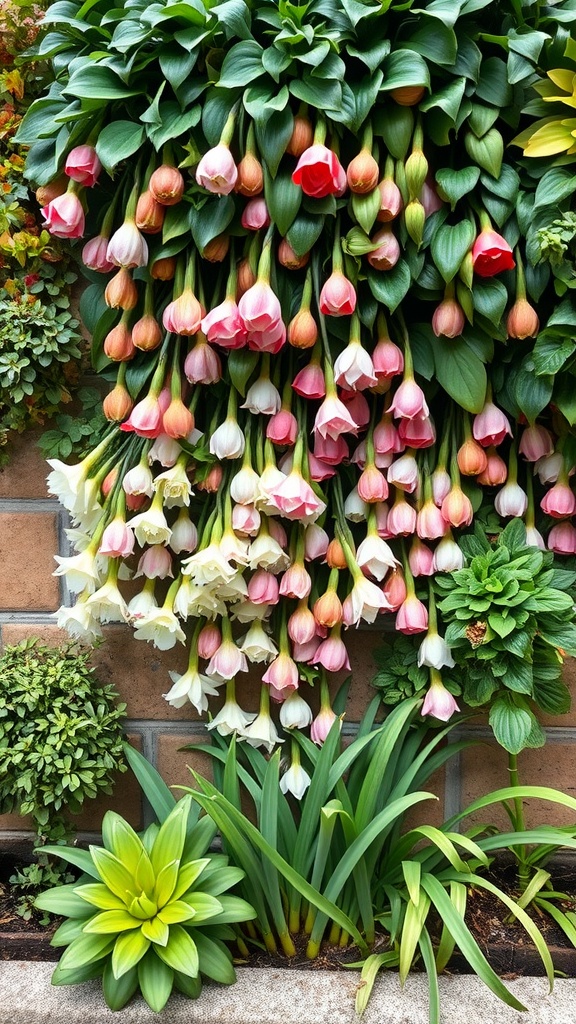
Vertical gardens are a fantastic way to bring life to your space, and using bulbs can make them even more stunning. This image showcases a beautiful arrangement of bulbs cascading down a wall, creating a vibrant display. The layers of flowers, especially the tulips and other bulbs, add depth and texture.
When you’re planning a vertical garden, bulbs are perfect for adding seasonal color. They bloom at various times, so you can have a changing display throughout the year. Planting bulbs like tulips or daffodils in wall pockets or hanging planters ensures your garden is never dull.
Consider mixing different bulb types for a more dynamic look. You can combine flowers with varying colors and heights, creating a striking visual effect. Plus, the greenery from the leaves complements the blooms beautifully, giving your vertical garden a lush, full appearance.
Seasonal Bulb Rotation Techniques
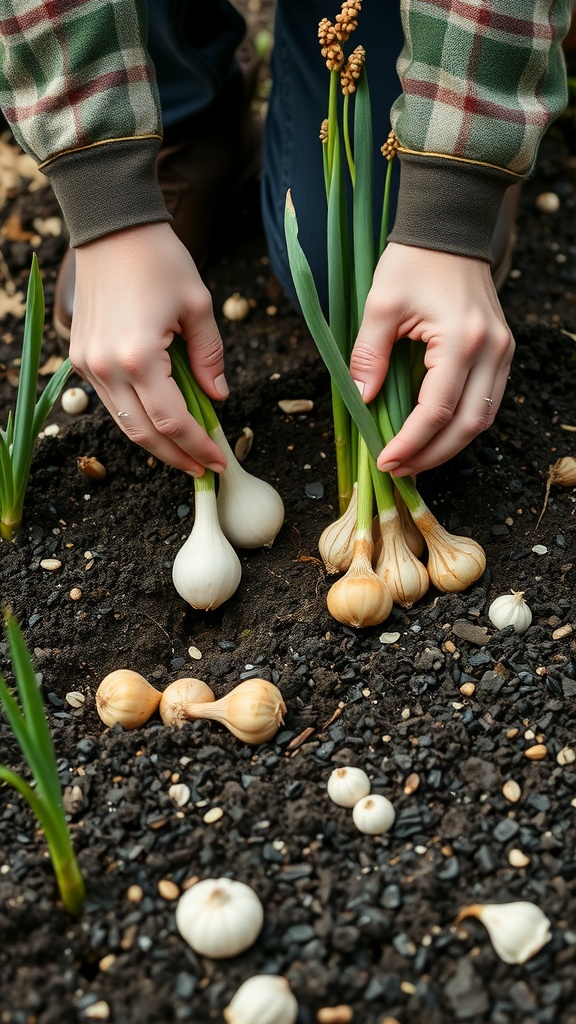
Using seasonal bulb rotation can breathe life into your garden throughout the year. In the image, we see someone harvesting bulbs from dark, rich soil. This hands-on approach is a perfect example of how to manage your garden effectively.
When planting bulbs, consider their blooming seasons. Early bloomers like crocuses and tulips can brighten up spring, while summer favorites such as lilies and dahlias add color later on. By rotating your bulbs, you can ensure that there’s always something in bloom.
Another technique is to group bulbs by height and color. This creates a visually appealing display and allows you to swap out bulbs easily as seasons change. Plus, it keeps maintenance simple as you can focus on one area of your garden at a time.
Bulb Care and Maintenance Tips
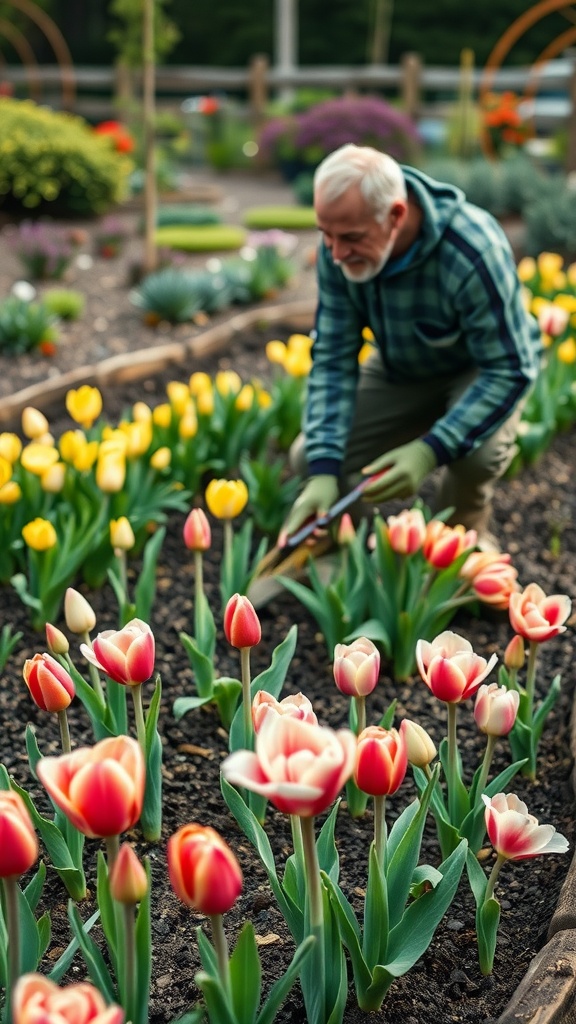
Taking care of bulbs is a rewarding process that allows you to enjoy beautiful blooms season after season. The image shows a dedicated gardener tending to a vibrant garden filled with tulips. It’s a perfect moment that reminds us of the joy bulbs can bring.
First, planting bulbs at the right time is key. Most bulbs thrive when planted in the fall or early spring. This gives them a chance to establish roots before the growing season hits. Ensure you’re planting in well-draining soil to avoid waterlogging.
Next, watering is essential, but moderation is vital. After planting, water the bulbs to help them settle in. During their growing phase, keep the soil moist but not soaked. Overwatering can lead to rot, which is a common issue.
Fertilizing your bulbs can also make a difference. Use a balanced fertilizer in early spring to provide nutrients as they start to grow. This helps them produce strong, colorful flowers.
Once the blooms fade, don’t rush to cut back the foliage. Allow the leaves to die back naturally. This process helps the bulb store energy for next year’s flowers. Regularly check for pests or diseases, and take action if needed to keep your garden healthy.
Creating a Bulb Garden for Small Spaces
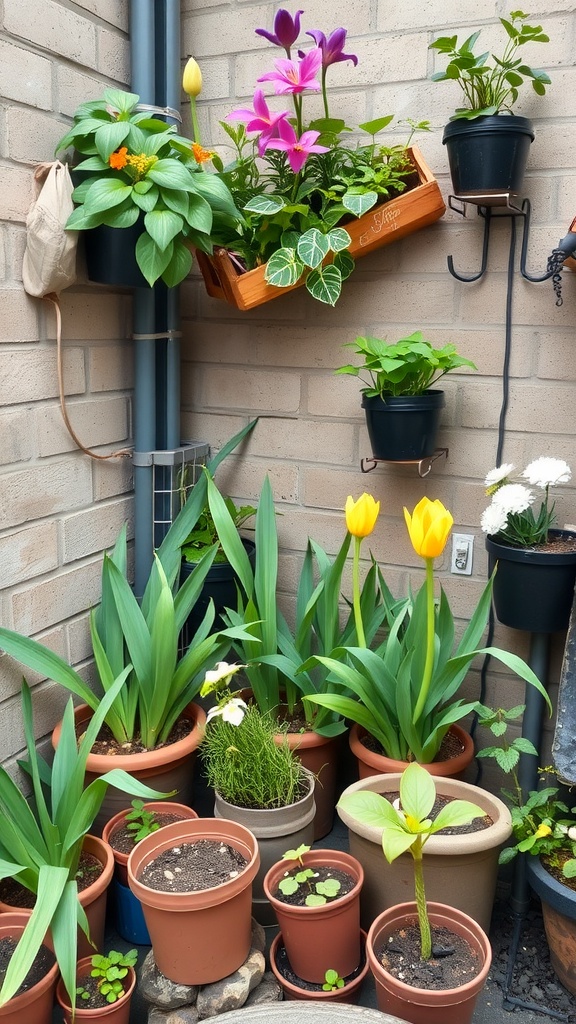
Transforming a small space into a colorful bulb garden can be a fun project. In the image, you can see a vibrant arrangement of potted plants and flowers. The mix of tulips, lilies, and other greenery creates a lively atmosphere. This setup shows how you can maximize visual interest without needing a large yard.
Using pots of varying sizes helps to create depth and dimension. Tall plants, like the yellow tulips, draw the eye upward, while smaller containers add layers at the base. Hanging planters also make great use of vertical space, allowing more plants to thrive without taking up precious ground space.
Consider grouping plants with different bloom times. This way, your garden stays interesting throughout the seasons. Mixing colors and textures can create a stunning visual. Don’t forget to add some herbs or trailing plants for variety. With a little creativity, even the tiniest balcony can burst with life!
